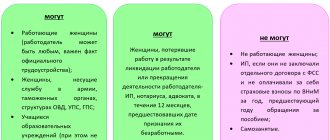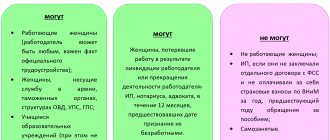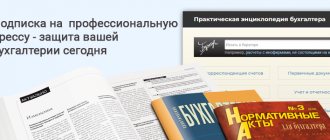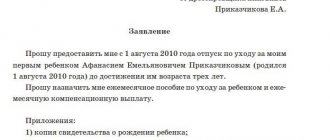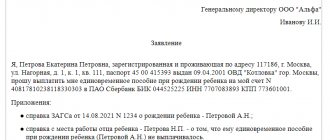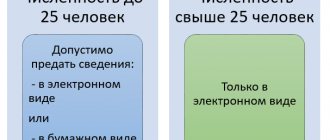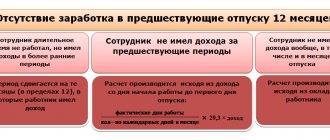Child benefits in 2019-2020
Every accountant should know what payments are provided by law for future and established parents. With the help of child benefits (BC), the state financially supports parents who are expecting a child, or those who already have a child.
All currently existing payments and those persons who are entitled to them are listed in Chapter. II of the Law “On State Benefits for Citizens with Children” dated May 19, 1995 No. 81-FZ. Any child benefit can be classified into one of the following groups:
- One-time:
- one-time benefit for registration in the early stages of pregnancy;
- maternity benefit (M&B);
- lump sum benefit for the birth of a child.
- Periodic:
- monthly child care allowance.
Some categories of persons have the right to such leave until the child reaches 3 years of age.
More details about this can be found in the article “Art. 256 of the Labor Code of the Russian Federation: questions and answers" .
Types of payments
Categories of government subsidies, the procedure for assigning them and the conditions for their provision are established at the federal level. Material support is one-time or monthly.
One-time payments
One-time subsidies related to pregnancy and the birth of a young Russian are a category of one-time material state support.
The expectant mother can receive some subsidies during pregnancy, before the baby is born. Read also: Posthumous establishment of paternity
PI&R (“maternity benefits”) belongs to the category of insurance protection measures, provided at the expense of the Social Insurance Fund. Money is paid in total for the entire vacation. Unlike PRR, only women have the right to count on PB&R:
- working;
- unemployed or who lost her job during the liquidation of an enterprise during the calendar year before receiving unemployed status;
- full-time student;
- contract military personnel;
- who has adopted a child (and corresponds to the listed groups).
It is important to know! If a mother is paid child care benefits at the time of calculating PB&R, she has the right to receive only one of them - at her choice.
In 2022, PB&R is paid only for vacation days of the same name. In other words, if a woman does not take advantage of the right to the required leave, continues to work and receive a salary, then she will not be paid benefits. An organization should not provide a woman with two categories of payments at the same time.
They receive money at their place of work or service. Other categories are available from local social security offices. If a woman has worked part-time in the same organizations for the previous 2 years, then payments are made by both employers.
Child Birth Benefit (BCB)
This is a one-time payment assigned to one of the parents.
It has a similar size and does not depend on the order of birth of the babies or the fact of employment. An application for a PRR must be submitted within six months of the baby’s birth. The amount of the benefit, taking into account the inflation factor of 1.043, from February 2022 amounted to 17,479.73 rubles. A family that has adopted a little Russian can count on the same amount. If a disabled child, children over 7 years old, or several relatives at the same time are taken into care, the payment will be 133,559.36 rubles.
Working northerners are entitled to an increased subsidy, multiplied by the regional coefficient. The conscript's wife will receive 27,680.97 rubles. When two or more children appear, the PRR relies on each one. If the baby is stillborn, no benefits are paid.
The PRP is assigned and paid by the employer no later than ten days from the date of submission of the package of documents. Social security authorities make payments to unemployed and full-time students no later than the 26th day of the month following the month in which the documentation was submitted.
If in a family with one non-working spouse, the second one works, then the PRR will be assigned to the working one.
One-time child payments in 2022 (calculation, documents for child benefits)
Only the mother of the child can count on a one-time allowance for BiR and for registration at the antenatal clinic.
The amount of the benefit for early registration is indexed annually. Since February 2022, it has been 628.47 rubles.
The amount of the B&R benefit is equal to 100% of the average daily earnings for the 2 years preceding the year of maternity leave.
The following materials will help you understand the procedure for calculating the BIR allowance:
- “How to correctly calculate maternity leave in 2019?”;
- “Maternity benefits for part-time workers”.
Any of the parents or the person replacing him/her has the right to count on a lump sum benefit paid at the birth of a child. The value of this DP is also indexed and from February 2022 is equal to 16,759.09 rubles.
Read more about DP indexation as of 02/01/2018 here.
To receive any of the payments, you must provide the employer with:
- application for benefits;
- a document confirming the right to receive DP (sick leave according to BiR, a certificate of registration in the early stages of pregnancy, a child’s birth certificate);
- a certificate stating that the second parent did not receive childbirth benefits, etc.
For the form of such a certificate, see the article “Certificate of non-receipt of a one-time benefit at the birth of a child.”
Support size
Let's look at the amounts.
| Category of citizens | Benefit amount |
| Benefits for women during pregnancy and childbirth | |
| Employed | Average daily earnings for the entire vacation in BiR |
| Minimum for workers |
|
| Maximum for workers |
|
| Unemployed people laid off due to liquidation of an enterprise (at the rate of 1 month) | 655,49 |
| Full-time students | In the amount of scholarship |
| Women soldiers | In the amount of the current salary |
| Registration in early pregnancy | 655,49 |
| Pregnant wives of conscripts | 27680,97 |
| At the birth of a child | 17479,73 |
| Upon adoption | 17479.73 or 133559.36 |
| Maternal capital | 466617 |
| Monthly benefits | |
| Caring for a baby up to 1.5 years old for a working mother | 40% of average earnings for the previous 2 years |
| Minimum up to 1.5 years for working mothers |
|
| Up to 1.5 years for unemployed women and those whose work experience is less than six months |
|
| "Putin" payments | Children's living wage |
| Caring for a military child | 11863,27 |
| For the loss of a breadwinner-soldier | 2386,02 |
| Payments for children from the Chernobyl zone |
|
| Payments for the third child under 3 years old | Children's living wage |
| Children under 18 years of age from low-income families | Set regionally |
Read also: Maternity capital during divorce
Other types of lump sum payments
There are other types of family support after the arrival of a new Russian citizen.
Maternal capital
The amount of maternity capital in 2022 is 466,617 rubles. There are no changes planned in the area of state benefits or the introduction of additional measures of social support for families after the birth of a newborn in 2022.
"Presidential" payments
In 2022, “presidential” subsidies established last year on the initiative of Vladimir Putin will continue to operate.
People began to call them “Putin’s”. This support measure is provided if the first or second baby is born (adopted). You can receive benefits until the child turns 3 years old. There are other conditions that confirm compliance with the criteria of need. The income (average per capita) of the applicant's family (for able-bodied citizens) should not exceed an amount equal to 2 subsistence minimums (ML) of a specific constituent entity of the Russian Federation. The benefit corresponds to the volume of regional children's PM: from 8291 rubles. in the Belgorod region up to 22,730 rubles. in the Chukotka Autonomous Okrug.
Regional benefits
In addition to federal support, Russia provides for regional protection measures (so-called “gubernatorial” assistance). The grounds for provision and amounts of payments are established by legal acts of local authorities.
Good to know! The size and types of regional subsidies directly depend on the economic state of a particular constituent entity of the Russian Federation and the capabilities of the local budget, and therefore sometimes differ significantly.
"Luzhkovskaya" help
To support young families in Moscow, so-called “Luzhkov” subsidies are paid. They are valid for one of the parents (adoptive parents) under 30 years of age. The family must meet the following requirements:
- both parents have permanent residence in the capital;
- the applicant lives permanently in Moscow and is registered in the city along with the child; in this case, the second parent may be registered in another city;
- single mother, resident of the capital;
- the only adoptive parent registered in Moscow along with the child.
Size is:
- for the first child - 5 PM established in Moscow in the current quarter;
- at the birth of the second baby - 7 PM;
- starting from the third - 10 reps.
"Gromovsky" payments in the Moscow region
Residents of the Moscow region also receive additional social support for the birth (adoption) of children: “Gromov” payments (named after the governor who signed the regional law).
This is a whole list:
- one-time PRR;
- monthly allowance for a newborn until he reaches 16-18 years of age;
- regional maternity capital;
- cash compensation for needy categories of families.
In the northern capital
In St. Petersburg, at the birth of a child and for children under 7 years of age, special additional assistance is paid using special children's cards. The money is intended only for non-cash payments - for children's goods and products from specialized stores.
What documents are needed to apply for child care benefits in 2019-2020?
Payment of DP for child care is also provided for by Law No. 81-FZ. This child benefit is issued to the family member who actually cares for the child. The list of persons is determined by Art. 13 of the said law. Currently, such DP can be obtained not only by parents or guardians, but also by other relatives, for example, grandparents. The most important criterion is that the person is actually with the child and caring for him.
Attention! Before you pay dad for baby, find out what mom is doing.
Moreover, those for whom such a DP is issued do not necessarily have to be employees of any organization. DP is also due to those who study at universities, vocational schools, and receive additional education. While a person is studying, he has no income on which contributions to the Social Insurance Fund are calculated, but despite this, the DP is paid.
The right to receive DP can be claimed by parents or relatives who were fired while caring for a child, as well as mothers who were fired during pregnancy. But the basis for dismissal (in both cases) must be the termination of the employer’s activities, for example, the liquidation of the organization.
Regulatory documents stipulate that if several family members are caring for a child, then only one is entitled to DP. This means that only one set of documents needs to be collected.
Questions regarding what documents are needed to receive child benefits, where to apply for them and from whom to expect payments are covered in detail in the order of the Ministry of Health and Social Development dated December 23, 2009 No. 1012n. In essence, this order is additional, more detailed instructions on the practical application of Law No. 81-FZ and the Law “On Compulsory Social Insurance in Case of Temporary Disability and in Connection with Maternity” dated December 29, 2006 No. 255-FZ.
After a set of documents for assigning a DP has been collected, it must be submitted to the organization that will assign, calculate and pay benefits. According to the order of the Ministry of Health and Social Development of December 23, 2009 No. 1012n, documents must be submitted to the place of work (for those for whom the employer pays insurance premiums), service (for military, firefighters, police, customs workers) or to the social security authorities at the place of residence (for all other categories).
Systematized information on documenting the calculation of DP can be found in the article “Assignment and payment of child care benefits up to 1.5 years old .
There are situations when the mother of a child under 1.5 years old receives benefits, works part-time and wants to go on annual leave.
“There can be only one leave: either annual or for child care” will tell you what to do correctly in this case .
See also: “Children’s benefit for part-time days - the Social Insurance Fund dictates the conditions.”
An employee who has a small child got sick and provided sick leave - what can she count on and what is the right thing for the company to do in this situation?
Read about this in the material “Working mothers of children have the right to sick pay .
Receipt procedure
The appointment of a PRR is of a declarative nature and requires the mandatory submission of an appropriate application with a package of necessary documents, determined by the category of parents.
Range of benefit recipients
A prerequisite for receipt is the very fact of the birth of the child.
The applicant may be one of the parents. Read also: Divorce by mutual consent
Funding sources define three categories of recipients:
- At the expense of the Social Insurance Fund - employed persons;
- At the expense of federal subsidies - full-time students, unemployed and unemployed, pensioners;
- At the expense of the federal budget - contract military personnel, employees of the Ministry of Internal Affairs, customs officers, firefighters.
Who can receive benefits?
According to federal law, the right to a one-time subsidy upon the birth of a newborn has one of the parents or a person replacing him (guardian, adoptive parent or foster parent).
What documents are needed to process the payment?
The specific list of documents depends on the category of the applicant. General required documents include:
- passport;
- application for payment of benefits for the birth of a child indicating personal data;
- certificate from the registry office about the birth of the baby (F 24);
Certificate form F24 - a certificate of non-receipt of a one-time PRP from work (service) or the social security department at the place of registration of the husband (if the father is applying for payment, a similar certificate from the mother is needed).
Sample certificate of non-receipt of a one-time benefit
The additional package includes the following documents:
- for the unemployed - an extract from the work book or other document confirming the last place of employment or study;
- for divorced applicants - a certificate from the housing organization confirming the cohabitation of the applicant with the newborn, a certificate of divorce;
- for non-workers - a certificate of non-assignment of support by social protection authorities at the place of registration.
Advice! The package of documents includes a certificate of non-receipt of benefits by the other parent. In the event of a tense relationship (especially in the case of divorce), if the young father suddenly refuses to provide such a certificate, the woman can solve the problem on her own by contacting her husband’s employer with an official letter containing a request for the document.
Procedural Features
The following parents are excluded from the category of PRP recipients:
- deprived of rights;
- those who moved for permanent residence to another state;
- whose children are transferred to state support.
The payment is not accrued to a non-working parent if the second one is employed (serves), to the father of a child born out of wedlock, to a parent after a divorce if the child remained with the other parent.
Amount of child benefit in 2019-2020
The amount of child care allowance for a child up to 1.5 years old, defined in Art. 15 of Law No. 81-FZ, is set as a percentage. The size of the DP is equal to 40% of the average monthly earnings.
The amount of such earnings is calculated taking into account Art. 14 of the law of December 29, 2006 No. 255-FZ. To obtain the average monthly earnings, income for the last two years is taken into account. In 2022, you need to take into account the income for 2022 and 2022.
How to correctly determine the years for calculation in situations where a woman has recently returned from such a vacation and has not worked for the allotted time, read the articles:
- “The Ministry of Labor explained how to replace the years of the billing period when calculating benefits if there is a maternity leave during it”;
- “The FSS has clarified the rules for replacing years of the calculation period if the insured event was preceded by a long maternity leave”.
This algorithm is suitable for those employees who, while on parental leave, continue to be on the organization’s staff.
After the child benefit has been calculated, it must be compared with the minimum. You can find out the minimum amount of the benefit in the material “ Minimum amount of benefit for child care up to one and a half years old .
Maternity payments
The right to maternity benefits for pregnancy and childbirth is granted to:
- officially employed and temporarily unemployed expectant mothers,
- military women,
- women who lost their jobs due to the liquidation of an enterprise,
- full-time students.
For working women, the payment is calculated based on the woman’s average official earnings over the last two years. If the average earnings during the specified period of time exceed the minimum wage, then the payment will be 100% of this amount. Otherwise, the woman is paid a fixed amount equal to the minimum wage, which from May 1, 2022 is 11,163 rubles.
Maximum and minimum amounts of maternity payments at the beginning of 2019:
| Duration of maternity leave in days | Minimum amount | Maximum amount |
| 140 (sick leave) | 51,919 rubles | 301,096.6 rubles |
| 156 (complicated childbirth) | 57,852.6 rubles | 335,507.64 rubles |
| 194 (multiple pregnancy) | 71,944.9 rubles | 417,233.86 rubles |
Maximum amount of child benefits in 2019-2020
The state sets not only the minimum value of the DP, but also the maximum. What are these conclusions based on? In laws No. 81-FZ and 255-FZ, which determine the procedure for calculating DP, only the income of employees on which contributions to the Social Insurance Fund are calculated is taken into account. And according to paragraph 1 of Art. 420 of the Tax Code of the Russian Federation (until 2022 - clause 4 of Article 8 of Law No. 212-FZ dated July 24, 2009), such contributions are accrued on the income of employees until they reach the limit (clause 3 of Article 421 of the Tax Code of the Russian Federation). This value is constantly indexed, the indexation coefficient is established annually by government decree. When determining it, the growth of average wages in the country is taken into account.
Thus, after calculating the average earnings, you need to compare it with the minimum value, calculated based on the minimum wage, and the maximum, calculated based on the established limits. If the calculated average earnings do not go beyond the “corridor”, then this should be taken into account. If it is below the minimum value, then the amount calculated on the basis of the minimum wage is taken into account. If the calculated average earnings are higher than the maximum, then you need to limit yourself to the “ceiling”.
Maternity capital in 2019
The amount of maternity capital in 2022 will remain at the same level and amount to 453,026 rubles. Regular indexation of maternity capital will resume only from 2022 and, as follows from the explanatory note to draft federal law No. 556363-7, the amount will increase:
- in 2022 - up to 470,241 rubles;
- in 2022 - up to 489,051 rubles.
The right to receive maternity capital appears in a family with the birth of a second child or subsequent ones, provided that the certificate was not previously received. Maternity capital can only be used for certain purposes:
- Improving living conditions,
- Children's education,
- formation of mother's pension,
- social adaptation of disabled children,
- monthly payments for the second child.
No one-time payments from maternity capital funds are provided.
According to the rules, maternity capital can be used only when the child for whom it was received reaches three years of age. But there are areas where the use of capital is possible immediately after the right to receive it:
- as down payment, interest or principal on a mortgage loan;
- payment for preschool education of children (including in private organizations);
- monthly allowance (the amount depends on the region of residence of the family);
- social adaptation of disabled children.
From 2022, funds from maternity capital can, in addition, be used to build a house on a garden plot. This became possible after the adoption of Law No. 217-FZ of July 29, 2017. From 2022, the pension fund will have 15 days rather than a month to make a decision on issuing maternity capital.
Read more about changes in maternity capital for 2022.
Payment of monthly child benefit
Payment of child benefits will be made by the organization where the necessary documents were submitted, or by the territorial branch of the Social Insurance Fund, if the company is participating in the Social Insurance Fund pilot project.
Which regions are included in this social insurance project, see the material “FSS pilot project - how to participate and what are the advantages?”
The period for calculating the DP is limited by Art. 15 of Law No. 255-FZ and is 10 days from the date of application. And the payment by the employing organization is made on the next day of payroll. The territorial body of the Social Insurance Fund has a total of 10 days from the date of receipt of the documents to calculate and pay the DP.
The legislation of the Russian Federation regarding the calculation of DP often changes: payments are indexed, the calculation procedure is adjusted. Children's benefits” will help you keep abreast of the latest changes and clarifications on the definition of DP .
Still have questions? Ask on our forum , and qualified specialists will answer you as soon as possible.
Presidential payments for the first and second child
Since 2022, a new measure to support families with children has come into effect - monthly payments for the birth of 1 and 2 children . People also call them “presidential” or “Putin’s”, since the corresponding law was developed on the initiative of Vladimir Putin (Law No. 418-FZ of December 28, 2017 on payments for families with children). These benefits are provided at the birth (adoption) of the first and/or second child , starting from January 1, 2022. Another mandatory requirement is meeting the need criterion. The monthly average per capita family income should not exceed one and a half times the subsistence minimum value for the working-age population for the 2nd quarter of last year operating in a particular region.
In 2022, the amount of payments is equal to the children's regional subsistence minimum established for the 2nd quarter of 2018 (you can find out its value for your region in the table). The benefit will be provided to the applicant:
- at the expense of the federal budget - if the child is the first ;
- from a maternity capital certificate - if a second child (in the form of monthly payments from maternity capital until the age of 1.5 years).
Presidential payments are assigned in parallel with other child benefits, without canceling them .
To start receiving monthly benefits, you must contact the territorial Social Security (for the first child) or the Pension Fund of the Russian Federation (if a second child was born or adopted). Although the period for providing payments is until the child turns one and a half years old , upon the first application they are assigned only for one year . In order for the benefit to be paid for the remaining six months, you must reapply for its assignment with updated documents.
